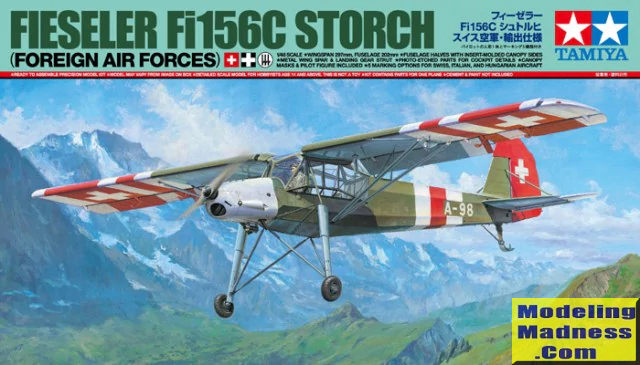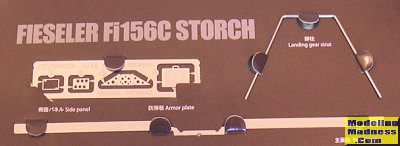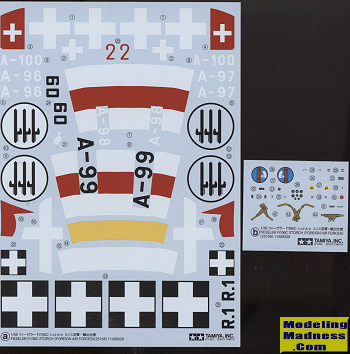
Tamiya 1/48 Fieseler Fi-156C Storch: Foreign Air Forces
| KIT #: | 25158 |
| PRICE: | 4500 yen SRP |
| DECALS: | Five options |
| REVIEWER: | Scott Van Aken |
| NOTES: | 2012 release. Includes etched parts and masks |

| HISTORY |
In 1935, the RLM (Reichsluftfahrtministerium, Reich Aviation Ministry) invited several aviation companies to submit design proposals that would compete for the production contract for a new Luftwaffe aircraft design suitable for liaison, army co-operation (today called forward air control), and medical evacuation. This resulted in the Messerschmitt Bf 163 and Siebel Si 201 competing against the Fieseler firm's entry. Conceived by chief designer Reinhold Mewes and technical director Erich Bachem, Fieseler's design had a far better short take off and landing ("STOL") performance. A fixed slat ran along the entire length of the leading edge of the long wings, while a hinged and slotted set of control surfaces ran along the entire length of trailing edge. This was inspired by earlier 1930s Junkers Doppelflügel, "double-wing" aircraft wing control surface design concepts. For the Fi 156, this setup along each wing panel's trailing edge was split nearly 50/50 between the inboard-located flaps and outboard-located ailerons, which, in turn, included trim tab devices over half of each aileron's trailing edge length.
A design feature rare for land-based aircraft enabled the wings on the Storch to be folded back along the fuselage in a manner similar to the wings of the U.S. Navy's Grumman F4F Wildcat fighter. This allowed the aircraft to be carried on a trailer or even towed slowly behind a vehicle. The primary hinge for the folding wing was located in the wing root, where the rear wing spar met the cabin. The long legs of the main landing gear contained oil-and-spring shock absorbers that had a travel of 40 cm (15-3/4 inches), allowing the aircraft to land on comparatively rough and uneven surfaces; this was combined with a "pre-travel" distance of 20 cm, before the oleos began damping the landing gear shock. In flight, the main landing gear legs hung down, giving the aircraft the appearance of a long-legged, big-winged bird, hence its nickname, Storch. With its very low landing speed, the Storch often appeared to land vertically, or even backwards in strong winds from directly ahead.
About 2,900 Fi 156s, mostly Cs, were produced from 1937 to 1945 at the Fieseler Factory in Kassel. In 1942, production started in the Morane-Saulnier factory at Puteaux in France. Due to the demand for Fieseler as a subcontractor for building the Bf 109 and the Fw 190, Storch production was shifted to the Leichtbau Budweis in Budweis in 1943.
License production was undertaken in Czechoslovakia, France, Romania, and the Soviet Union with most plants still producing the type post war. French production did not cease until 1965.| THE KIT |
 r
options are a pilot figure, the ability to model the flaps raised or lowered
and a set of skis. You can also build a variant without the rear gun; a flat
panel piece being provided for this.
r
options are a pilot figure, the ability to model the flaps raised or lowered
and a set of skis. You can also build a variant without the rear gun; a flat
panel piece being provided for this.
The instructions recommend a special metal primer for
use on the metal bits so that standard paint will stick. Once the base fuselage
is built, then one starts adding things like the wing spar, engine, windscreen,
and the pilot/seat. Several construction steps are dedicated to building up the
landing gear before moving on to the flight surfaces. As mentioned, you can do
flaps up or down and there are separate hinge pieces for this. Some of the last
steps are for the wing struts and underwing bits before adding the prop. Note
that throughout the build, you are provided with a guide as to which parts are
for use with which of the markings options. Only one of these is armed th ough
most have the gun port.
ough
most have the gun port.
Instructions are very well done with detail images provided where needed. As usual, only Tamiya paint references are provided. There are three Swiss options; two are RLM 71 over 65 while a third is overall silver. Two of the three have the red and white markings used during the war. Some of these markings will need to be painted on though the fuselage bands have been provided. . The silver option has the flat upper canopy section. The other two are in the splinter pattern of RLM 70/71/65. One is an Italian plane from 1942 with a white fuselage stripe and yellow forward nose. The other is a Hungarian version with yellow fuselage band and lower wing tips. The fin and tailplanes are in red, white, green making for a very colorful plane. Tamiya provides a separate set of painting instructions in a fold out format. Decals are nicely printed and should offer no issues.
| CONCLUSIONS |
| REFERENCES |
June 2019
Back to the Main Page Back to the Previews Index Page
Back to the Previews Index Page